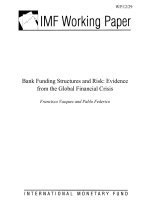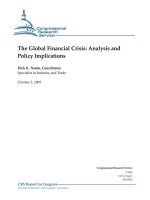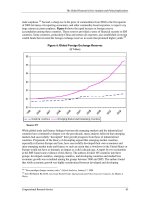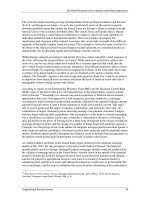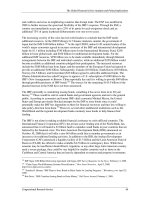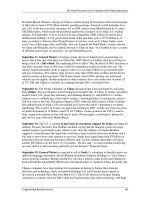Lessons from the global financial crisis and recommendations to vietnamese banking sector
Bạn đang xem bản rút gọn của tài liệu. Xem và tải ngay bản đầy đủ của tài liệu tại đây (22.17 MB, 174 trang )
VIETNAM NATIONAL UNIVERSITY, HANOI
SCHOOL OF BUSINESS
n
t l
- I I S
B-
VU MINH HUONG
LESSONS FROM THE GLOBAL FINANCIAL CRISIS AND
RECOMMENDATIONS TO VIETNAMESE BANKING SECTOR
Major : Business Administration
Code : 60 34 05
MASTER OF BUSINESS ADMINISTRATION THESIS
Supervisor : Dr. Tran Phuong Lan
đai học q uo c
O 'a
HP
IV
V
TRUNG TẦM THONG Tin ĨHỰ yi£N
ầ r L o / 6 9 ..
Hanoi - 2010
TABLE OF CONTENTS
Acknowledue...........................................................................................................
i
Abstract....................................................................................................................
ii
Tóm tat.....................................................................................................................
vi
1 able o f contents...................................................................................................
xi
List of Abbreviations............................................................................................
XV
List of Tables..........................................................................................................
xvii
List cf B o x e s...........................................................................................................
xviii
List if Figures.........................................................................................................
xix
Introduction...........................................................................................................
1
CHAPTER 1: GLOBAL FINANCIAL CRISIS AND ITS CAUSES
AND EFFECTS TO THE WORLD BANKING SECTOR........................
4
1.1. Financial crises and its impacts to the econom y....................................
4
1.1.1. Definition o f a financial crisis....................................................................
4
1.1.2. Types of financial crises.............................................................................
4
1.1.3. Causes of financial crises............................................
7
1.1.4. Impacts o f financial crises to the economy in history............................
10
1.2. Global financial crisis in 2008 - 2009.....................................................
19
1.2.1. The causes o f the c ris is ..............................................................................
19
1.2.2. The development o f the crisis....................................................................
33
1.3. Impacts of global financial crisis to the world banking sector.........
34
1.3.1. IvOsses and default increase due to owning or financing mortgage
derivaiives................................................................................................................
34
1.3.2. Limited liquidity in the system - impact from difficult inter-bank
market........................................................................................................................
36
1.3.3. Losses in market value as stock price plummeted...................................
39
1.3.4. Banking activities stagnancy and Credit drain.........................................
41
xi
1.3.5 Collapses and Merger & Acquisition, nationalization............................
42
1.3.6 Confidence in banking system deterioration............................................
45
1.3.7 The end of investment banks era................................................................
46
1.3.8 Large-scale lay-off, dismissal and unemployment in banks.................
47
CHAPTER 2: ANALYSIS THE VIETNAMESE BANKING
SECTOR BEFORE AND AFTER THE FINANCIAL CRISIS
52
2.1. \ietnamese socio-economic context during global financial crisis....
52
2.1.1. Excessive capital inflow..............................................................................
52
2.1.2. Inflation challenge and credit growth.......................................................
53
2.1.3. Stock market sliding and real estate bubble swelling.............................
54
2.1.4.Twin deficit...................................................................................................
55
2.2 Tie Vietnamese banking sector before global financial crisis.............
56
2.2.1. Early stage o f development.........................................................................
56
2.2.2. Fast growth....................................................................................................
58
2.2.3. Banking sector structure..............................................................................
59
2.2.4. Participation o f economic groups into banking sector............................
64
2.2.5. Undiversified banking services..................................................................
65
2.2.6. \Veak risk management...............................................................................
66
2.2.7. )ver heated loan growth in 2007...............................................................
66
2.2.8. Cooling loan growth rate in 2008..............................................................
68
2.2.9. \ mapping of Vietnamese banks before the global crisis....................
69
2.3 Vietnamese banking sector after Global Financial C risis....................
73
2.3.1. Analyzing Vietnamese banks by CAMELS model.................................
73
2.3.2. Bank mapping in the crisis (in 2008)........................................................
83
2.3.3. Bank mapping after the crisis (in 2009)....................................................
88
2.3.4. Little change in market share......................................................................
90
2.3.5. Mergers & Acquisition (M&A)................................................................
89
2.3 6. Inpacts on foreign banks in Vietnam.......................................................
92
xii
2.3.7. Little change in banking personnel...........................................................
93
2.4. Analysis of the similarities and differences between the Vietnamese
and US banking sector context before and during the financial crisis....
94
2.4.1. Similarities of the Vietnamese and u s banking sector context before
and during the financial crisis................................................................................
94
2.4.2. Differences of Vietnamese banking sector context to u s context
leading to the global financial crisis.....................................................................
97
Summary of Chapter 2.........................................................................................
100
c HAPTER 3: LESSONS AND RECOMMENDATIONS...........................
101
3.1. Lessons from the global financial crisis....................................................
102
3.1.1. Improving capitalization and leverage management lessons.................
102
3.1.2. Risk Management practices lessons...........................................................
104
3.1.3. Separating commercial banks from investment banks.............................
111
3.1.4. Transparency improvement lessons from u s and Euro zone’s banks...
112
3.2. Recommendations to the Vietnamese Banking sector...........................
115
3.2.1 Recommendations to Policy making level...............................................
115
3.2.1.1. More oversight and supervision from the authorities...........................
115
3.2.1.2. Building SBV into a Central Bank in its exact meaning......................
117
3.2.1.3. Upgrading the legal system.......................................................................
124
3.2.1.4. Transparency improvement in authorities level.....................................
124
3.2.1.5. Improving deposit insurance activities...................................................
125
3.2.1.6. Improving banking personnel in Government level.............................
127
3.2.2. Recommendations to banking governance and management.........
128
3.2.2.1. Improving capitalization in commercial banks......................................
128
3.2.2.2. Improving liquidity management in commercial banks......................
129
3.2.2.3. More robust risk management in commercial banks............................
129
3.2.2.4. Mergers and Acquisitions (M&A) activities in banks.........................
134
3.2.2.5. Improving transparency in Vietnamese commercial b a n k s ...............
134
XI I I
3.2.2.6. Developing banking services by diversification and IT investment...
135
3.2.2.7. Improving personnel from commercial bankslevel..............................
137
Summary of Chapter 3 ..........................................................................................
138
Conclusion................................................................................................................
139
Bibliography..............................................................................................................
140
Annex 01 ...................................................................................................................
146
Annex 02....................................................................................................................
156
Annex 03 ...................................................................................................................
159
G lossary....................................................................................................................
160
xiv
LIST OF ABBREVIA TIONS
SOCB
State-owned commercial bank
J SB
Joint-stock bank
SBV
State bank of Vietnam
MOF
Ministry of Finance
IMF
International Monetary Fund
WB
World Bank
DIV
Deposit Insurance o f Vietnam,
SCIC
State Capital Investment Corporation
FED
Federal Reserve
CPI
Consumer Pricing Index
MBS
Mortgage-backed security
SEC
Securities and Exchange Commission
ARM
Adjustable-rate mortgage
CDO
Collateralized debt obligation
CLO
Collateralized Loan Obligation
CDS
Credit Default Swap
ABS
Asset-backed security
CRA
Credit rating agencies
BHC
Bank holding company
Ỉ D ie
Federal Deposit Insurance Corporation
SOE
State-owned enterprise
NPL
Non-Performing-Loan ratio
ROA
Return On Asset
ROAA
Return On Average Asset
ROE
Return On Equity
ROAE
Return On Average Equity
VAS
Vietnamese Accounting Standards
IHRS
International Financial Reporting Standards
NIM
Net interest margins
SSG
Senior Supervisors Group
NBFI
Non-bank financial institution
CAR
Capital Ratio
ECB
European Central Bank
TARP
Troubled Asset Relief Program
LIST OF TABLES
Chapter 1:
Table 1.1: Depreciation in GNP in some ASEAN Nations in 1997-1998
Table 1.2: Depreciation of some ASEAN Nation’s currency in 1997-1998
Table 1.3: Depreciation of some ASEAN Nation's Per capita income
in 1997-2005
Table 1.4: Preliminary Capital Appreciation Contributions to the S&P500
Table 1.5: Number o f job cuts from banks, insurer and funds since August
2007
Chapter 2:
Table 2.1: Financial Markets in Vietnam (Percentage of GDP)
Table 2.2: Banking Sector in Vietnam (Percentage of market share)
Table 2.3: Foreign strategic stakes in Vietnamese Banks
Table 2.4: Investment of economic groups and SOEs
Table 2.5: Profit comparison o f Vietnamese banks and banks in other
countries
Table 2.6: Profitability and of Efficiency of Vietnamese banks in 2008
Table 2.7: Sliding bank stock price in 2008, 2009
xvii
LIST OF BOXES
Chapter 1:
Box 1.1: A short list o f some major financial crises since 20th century
Box 1.2: How are MBSs (Mortgage backed securities) traded?
Box 1.3: A bank run - Northern Rock
xviii
LIST OF FIGURES
Chapter 1:
Figure 1.1: Unemployment Rate o f us (1890 - 2008)
Figure 1.2: USA annual real GDP from 1910-60
Figure 1.3: Wall Street Crash on the Dow Jones Industrial Average 1929
Figure 1.4:
us Credit Market Debt as Percentage of GDP
Figure 1.5: Growth in
Figure 1.6:
us
us Household Mortgage Debt
Sub-prime mortgage loans in total mortgage loans (Quantity
and percentage)
Figure 1.7: Breakdown o f Securities Backed by
us
Home Mortgage
Collateral (January 2007)
Figure 1.8: The Growth of the CDSs Market
Figure 1.9: Moody's Profit per Employee vs. Total ABSs Issuance
Figure 1.10: Northern Rock share prices, day open (2005-2008)
Figure 1.11: Market value in October 2008 compared with Quarter 2, 2007
Figure 1.12: Gold price fluctuation from September 2008 to 2009
Chapter 2:
Figure 2.1: Investment growth and investment over GDP ratio in 1997-2007
Figure 2.2: Money and Credit indicators
Figure 2.3: Inflation of Vietnam from 01/2007 to 04/2009
xix
C.33.44.55.54.78.65.5.43.22.2.4..22.Tai lieu. Luan 66.55.77.99. van. Luan an.77.99.44.45.67.22.55.77.C.37.99.44.45.67.22.55.77.C.37.99.44.45.67.22.55.77.C.37.99.44.45.67.22.55.77.C.33.44.55.54.78.655.43.22.2.4.55.22. Do an.Tai lieu. Luan van. Luan an. Do an.Tai lieu. Luan van. Luan an. Do an
Figure 2.4: Vietnam's Twin Deficits 2003-2008
Figure 2.5: Vietnam's banking market is in an early stage o f development
Figure 2.6: Cash over M2 o f Vietnam, compared with regional countries
Figure 2.7: Market share o f Vietnamese banks
Figure 2.8: Deposit market share 2008
Figure 2.9: Credit market share 2008
Figure 2.10: Credit growth and deposit growth versus GDP growth
Figure 2.11: Lending procedures in JCBs
Figure 2.12: Credit growth for 7 months in 2008
Figure 2.13: Banks’ mapping in 2007
Figure 2.14: NPLs ratio under VAS
Figure 2.15: NPLs ratio under VAS and IFRS
Figure 2.16: NPLs on some Vietnamese banks by 2008-end
Figure 2.17: After-tax profit o f 2008 compared with 2007 for some
Vietnamese banks
Figure 2.18: Efficiency Ratios o f commercial banks in 2008
Figure 2.19: Price figure oflisted banks compared with VN Index
Figure 2.20: Banks grouping 2008
Figure 2.21: Bank mapping plan in 2009
Figure 2.22: Breakdown o f Capital Flows into Vietnam
Figure 2.23: Real Estate's outstanding loans on total outstanding loans
Figure 2.24: Vietnamese stock market from 2000 to now
XX
@edu.gmail.com.vn.bkc19134.hmu.edu.vn
C.33.44.55.54.78.65.5.43.22.2.4..22.Tai lieu. Luan 66.55.77.99. van. Luan an.77.99.44.45.67.22.55.77.C.37.99.44.45.67.22.55.77.C.37.99.44.45.67.22.55.77.C.37.99.44.45.67.22.55.77.C.33.44.55.54.78.655.43.22.2.4.55.22. Do an.Tai lieu. Luan van. Luan an. Do an.Tai lieu. Luan van. Luan an. Do an
INTRODUCTION
Necessity of the thesis
Financial crises are no strangers to world economies in recent times: the collapse
o f the savings and loans industry in the United States in the 1980s, the Asian
financial crisis of the 1990s. But the recent
us
mortgage sub-prime crisis was
truly different. Stunning in its breadth, speed and dramatic consequences (Cally
Jordan , 2009), the
us
crisis spread widely into the global financial crisis and
affects almost every comer of the world
Around the world, hundreds of millions of people are affected. Almost every
countries, rich and poor are affected, however, at different level.
Banking industry is one of the most impacted areas. The crisis has a reverse
pattern. Crisis moved from the financial sector to the real economy. And then
weakening o f corporate sector will spread to financial sector.
Vietnam, no longer cut off from the world economy, was hit too. As the more
integrated into the world economy, the more Vietnam’s economy affected by the
up and down in the world economy.
In a developing country like Vietnam,
though the impacts on banks are not as directed as those in the
us, but are large
enough for bank management boards, investors, officials, law makers, specialists
as well as depositors to concern about.
Many international and domestic researches have been carried out on the impacts
of the global financial crisis to the economy of Vietnam, but few of them
emphasize the lessons from the global financial crisis to the Vietnamese banking
1
@edu.gmail.com.vn.bkc19134.hmu.edu.vn
C.33.44.55.54.78.65.5.43.22.2.4..22.Tai lieu. Luan 66.55.77.99. van. Luan an.77.99.44.45.67.22.55.77.C.37.99.44.45.67.22.55.77.C.37.99.44.45.67.22.55.77.C.37.99.44.45.67.22.55.77.C.33.44.55.54.78.655.43.22.2.4.55.22. Do an.Tai lieu. Luan van. Luan an. Do an.Tai lieu. Luan van. Luan an. Do an
sector and recommendations for it. That is the reason for the author to carry out
this
research
“Lessons
from
the
Global
Financial
Crisis
and
Recommendations to Vietnamese Banking Sector".
Another reason for choosing this topic is that the banking sector holds an
essential part in economic development in every country. In Vietnam as many
Asian countries alike, banks play a key role in channeling credit to firms,
particularly those firms not able to acquire funding from capital markets or other
sources. Besides, banks also serve as custodian o f a significant portion of
household saving.
For these above reasons and due to self interest, through this thesis, the author
hopes to sketch and analyze some impacts of the global crisis on Vietnamese
banking sector in order to draw some lessons and recommendations for
Vietnamese banks and the authorities to overcome difficulties in challenging
time to come and better prevent possible crises.
Scope of work
The thesis covers impacts of the global turmoil on both the world and
Vietnamese banking industry. And it focuses on Vietnamese banking industry
conditions before and after the crisis to draw lessons and recommendations to
this industry.
Methodology
To fulfill the thesis, the author use qualitative interviews with local banks
managers, state officials and Vietnamese and foreign experienced experts in
banking and finance to understand the causes and effects o f the global financial
@edu.gmail.com.vn.bkc19134.hmu.edu.vn
C.33.44.55.54.78.65.5.43.22.2.4..22.Tai lieu. Luan 66.55.77.99. van. Luan an.77.99.44.45.67.22.55.77.C.37.99.44.45.67.22.55.77.C.37.99.44.45.67.22.55.77.C.37.99.44.45.67.22.55.77.C.33.44.55.54.78.655.43.22.2.4.55.22. Do an.Tai lieu. Luan van. Luan an. Do an.Tai lieu. Luan van. Luan an. Do an
crisis to the world and Vietnamese banking sector to draw lessons and
recommendations to the local sector.
Besides, various recent reports on banks from international organizations and
local banks as well as securities companies are a worthy reference information.
Internet searching in reliable websites contributes some good data to the thesis.
Contributions of the thesis
The thesis contributes some lessons from the current global financial crisis to the
banking industry o f the world in general and of Vietnam in particular. Then it
draw some recommendations to Vietnamese authorities and banking managers in
ways to tackle the global crisis and ways to better prepare for possible future
crisis.
3
@edu.gmail.com.vn.bkc19134.hmu.edu.vn
C.33.44.55.54.78.65.5.43.22.2.4..22.Tai lieu. Luan 66.55.77.99. van. Luan an.77.99.44.45.67.22.55.77.C.37.99.44.45.67.22.55.77.C.37.99.44.45.67.22.55.77.C.37.99.44.45.67.22.55.77.C.33.44.55.54.78.655.43.22.2.4.55.22. Do an.Tai lieu. Luan van. Luan an. Do an.Tai lieu. Luan van. Luan an. Do an
CHAPTER 1
GLOBAL FINANCIAL CRISIS 2007 - 2009 AND ITS CAUSES AND
EFFECTS TO THE WORLD BANKING SECTOR
1.1. Financial crises and its impacts to the economy
1.1.1. Definition of a financial crisis
The term financial crisis is applied broadly to a variety of situations in which
some financial institutions or assets suddenly lose a large part of their value
(D.D. C'haturvedi, 2009). In the 19th and early 20th centuries, many financial
crises were associated with banking panics, and many recessions coincided with
these panics. Other situations that are often called financial crises include stock
market crashes and the bursting of other financial bubbles, currency crises, and
sovereign defaults(1\
A financial crisis can be understood as a loss of confidence in a country's
currency or other financial assets causing international investors to withdraw
their funds from the country. Financial crisis can be in many different types as
mentioned below.
1.1.2. Types of financial crises
/. 1.2. /. Banking crises
When a bank suffers a sudden rush of withdrawals by depositors, this is called a
bank run (D.D. Chaturvedi, 2009).
Since banks lend out most o f the cash they receive in deposits, it is difficult for
them to quickly pay back all deposits if these are suddenly demanded, so a run
may leave the bank in bankruptcy, causing many depositors to lose their savings
unless they are covered by deposit insurance. A situation in which bank runs are
4
@edu.gmail.com.vn.bkc19134.hmu.edu.vn
C.33.44.55.54.78.65.5.43.22.2.4..22.Tai lieu. Luan 66.55.77.99. van. Luan an.77.99.44.45.67.22.55.77.C.37.99.44.45.67.22.55.77.C.37.99.44.45.67.22.55.77.C.37.99.44.45.67.22.55.77.C.33.44.55.54.78.655.43.22.2.4.55.22. Do an.Tai lieu. Luan van. Luan an. Do an.Tai lieu. Luan van. Luan an. Do an
widespread is called a systemic banking crisis or just a banking panic (D.D.
Chaturvedi, 2009). A situation without widespread bank runs, but in which banks
are reluctant to lend, because they worry that they have insufficient funds
available, is often called a credit crunch. In this way, the banks become an
accelerator of a financial crisis.
Examples o f bank runs include the run on the Bank o f the United States in 1931
and the run on Northern Rock in 2007. The collapse o f Bear Stearns in 2008 has
also sometimes been called a bank run. even though Bear Steams was an
investment bank rather than a commercial bank. The U.S. savings and loan crisis
of the 1980s led to a credit crunch which is seen as a major factor in the U.S.
recession o f 1990-91 ().
/. 1.2.2. Speculative bubbles and crashes
Economists say that a financial asset (for example: stock, property...) exhibits a
bubble when its price exceeds the present value o f the future income (such as
interest or dividends) that would be received by owning it to maturity. If most
market participants buy the asset primarily in hopes o f selling it later at a higher
price, instead of buying it for the income it will generate, this could be evidence
that a bubble is present. If there is a bubble, there is also a risk o f a crash in asset
prices: market participants will go on buying only as long as they expect others
to buy, and when many decide to sell, the price will fall (D.D. Chaturvedi, 2009).
Well-known examples o f bubbles and crashes in stock prices and other asset
prices include the Dutch tulip mania, the Wall Street Crash of 1929, the Japanese
property bubble of the 1980s, the crash o f the dot-com bubble in 2000-2001, and
US housing bubble in 2006.
@edu.gmail.com.vn.bkc19134.hmu.edu.vn
C.33.44.55.54.78.65.5.43.22.2.4..22.Tai lieu. Luan 66.55.77.99. van. Luan an.77.99.44.45.67.22.55.77.C.37.99.44.45.67.22.55.77.C.37.99.44.45.67.22.55.77.C.37.99.44.45.67.22.55.77.C.33.44.55.54.78.655.43.22.2.4.55.22. Do an.Tai lieu. Luan van. Luan an. Do an.Tai lieu. Luan van. Luan an. Do an
/. 1.2.3. Financial crises
When a country that maintains a fixed exchange rate is suddenly forced to
devalue its currency because o f a speculative attack, this is called a currency
crisis or balance o f payments crisis. When a country fails to pay back its
sovereign debt, this is called a sovereign default. While devaluation and default
could both be voluntary decisions of the government, they are often perceived to
be the involuntary' results o f a change in investor sentiment that leads to a sudden
stop in capital inflows or a sudden increase in capital flight (D.D. Chaturvedi,
2009).
Several currencies that formed part o f the European Exchange Rate Mechanism
suffered crises in 1992-93 and were forced to devalue or withdraw from the
mechanism. Another round o f currency crises took place in Asia in 1997-98.
Many Latin American countries defaulted on their debt in the early 1980s. The
1998 Russian financial crisis resulted in a devaluation o f the ruble and default on
Russian government bonds.
/. 1.2.4. Wider economic crises
Negative GDP growth lasting two or more quarters is called a recession. An
especially prolonged recession may be called a depression, while a long period
o f slow but not necessarily negative growth is sometimes called economic
stagnation (D.D. Chaturvedi, 2009).
Since these phenomena affect much more than the financial system, they are not
usually considered financial crises by nature. But some economists have argued
that many recessions have been caused in large part by financial crises. One
important example is the Great Depression, which was preceded in many
6
@edu.gmail.com.vn.bkc19134.hmu.edu.vn
C.33.44.55.54.78.65.5.43.22.2.4..22.Tai lieu. Luan 66.55.77.99. van. Luan an.77.99.44.45.67.22.55.77.C.37.99.44.45.67.22.55.77.C.37.99.44.45.67.22.55.77.C.37.99.44.45.67.22.55.77.C.33.44.55.54.78.655.43.22.2.4.55.22. Do an.Tai lieu. Luan van. Luan an. Do an.Tai lieu. Luan van. Luan an. Do an
countries by bank runs and stock market crashes. The subprime mortgage crisis
and the bursting of other real estate bubbles around the world has led to
recession in the U.S. and a number o f other countries in late 2008 and 2009.
1.1.3. Causes of financial crises
When looking at financial crises in history, though they have some different
developments, they had some similarities in their causes.
1.1.3.1. Strategic complementarities
It is often observed that successful investment requires each investor in a
financial market to guess what other investors will do. In many cases investors
have incentives to coordinate their choices. For example, someone who thinks
other investors want to buy lots o f Japanese yen may expect the yen to rise in
value, and therefore has an incentive to buy yen too. Likewise, a depositor in
Indy Mac Bank who expects other depositors to withdraw their funds may expect
the bank to fail, and therefore has an incentive to withdraw too. Economists call
an incentive to imitate the strategies o f others strategic complementarity
().
1.1.3.2. Leverage
Leverage, which means borrowing to finance investments is frequently cited as a
contributor to financial crises. When a financial institution (or an individual)
only invests its own money, it can, in the very worst case, lose its own money.
But when it borrows in order to invest more, it can potentially earn more from its
investment, but it can also lose more than all it has. Therefore leverage magnifies
the potential returns from investment, but also creates a risk of bankruptcy. Since
bankruptcy means that a firm fails to carry out all its promised payments to other
@edu.gmail.com.vn.bkc19134.hmu.edu.vn
C.33.44.55.54.78.65.5.43.22.2.4..22.Tai lieu. Luan 66.55.77.99. van. Luan an.77.99.44.45.67.22.55.77.C.37.99.44.45.67.22.55.77.C.37.99.44.45.67.22.55.77.C.37.99.44.45.67.22.55.77.C.33.44.55.54.78.655.43.22.2.4.55.22. Do an.Tai lieu. Luan van. Luan an. Do an.Tai lieu. Luan van. Luan an. Do an
firms, it may spread financial troubles from one firm to another. The average
degree o f leverage in the economy often rises prior to a financial crisis.
1.1.3.3. Asset-Hability mismatch
Another factor believed to contribute to financial crises is asset-liability
mismatch, a situation in which the risks associated with an institution's debts and
assets are not appropriately aligned (). For example,
commercial banks offer deposit accounts which can be withdrawn at any time
and they use the proceeds to make long-term loans to businesses and
homeowners. The mismatch between the banks' short-term liabilities (its
deposits) and its long-term assets (its loans) is seen as one o f the reasons bank
runs occur (when depositors panic and decide to withdraw their funds more
quickly than the bank can get back the proceeds o f its loans).
In an international context, many emerging market governments are unable to
sell bonds denominated in their own currencies, and therefore sell bonds
denominated in
us
dollars instead. This generates a mismatch between the
cuưency denomination o f their liabilities (their bonds) and their assets (their
local tax revenues), so that they run a risk of sovereign default due to
fluctuations in exchange rates.
1. 1.3.4. Lack o f knowledge
Many analyses of financial crises emphasize the role o f investment mistakes
caused by lack of knowledge. It is pointed out that crises often follow soon after
major financial or technical innovations that present investors with new types of
financial opportunities. Unfamiliarity with recent technical and financial
8
@edu.gmail.com.vn.bkc19134.hmu.edu.vn
C.33.44.55.54.78.65.5.43.22.2.4..22.Tai lieu. Luan 66.55.77.99. van. Luan an.77.99.44.45.67.22.55.77.C.37.99.44.45.67.22.55.77.C.37.99.44.45.67.22.55.77.C.37.99.44.45.67.22.55.77.C.33.44.55.54.78.655.43.22.2.4.55.22. Do an.Tai lieu. Luan van. Luan an. Do an.Tai lieu. Luan van. Luan an. Do an
innovations may help explain how investors sometimes overestimate asset
values.
Recently, the crash of the dot com bubble in 2001 arguably began with too much
delightment with Internet technology.
If the first investors in a new class of
assets (for example, stock in "dot com" companies) profit from rising asset
values as other investors leam about the innovation, then still more others may
follow their example, driving the price even higher as they rush to buy in hopes
of similar profits. If such "herd behavior" causes prices to spiral up far above the
true value of the assets, a crash may become inevitable. If for any reason the
price briefly falls, so that investors realize that further gains are not assured, then
the spiral may go into reverse, with price decreases causing a rush o f sales,
reinforcing the decrease in prices.
1.1.3.5. Regulatory failures
Governments have attempted to eliminate or mitigate financial crises by
regulating the financial industry. Regulation has two main goals. The first one is
transparency, that is making institutions' financial situations publicly known by
requiring regular reporting under standardized accounting procedures. The
second goal is making sure institutions have sufficient assets to meet their
obligations, through reserve requirements, capital requirements, and other limits
on leverage.
However, excessive regulation has also been cited as a possible cause of
financial crises. In particular, the Basel II Accord has been criticized for
requiring banks to increase their capital when risks rise, which might cause them
to decrease lending precisely when capital is scarce, potentially aggravating a
financial crisis.
9
@edu.gmail.com.vn.bkc19134.hmu.edu.vn
C.33.44.55.54.78.65.5.43.22.2.4..22.Tai lieu. Luan 66.55.77.99. van. Luan an.77.99.44.45.67.22.55.77.C.37.99.44.45.67.22.55.77.C.37.99.44.45.67.22.55.77.C.37.99.44.45.67.22.55.77.C.33.44.55.54.78.655.43.22.2.4.55.22. Do an.Tai lieu. Luan van. Luan an. Do an.Tai lieu. Luan van. Luan an. Do an
1.1.3.6. Fraud
Fraud has played a role in the collapse of some financial institutions, when
companies have attracted depositors with misleading claims about their
investment strategies, or have stolen the resulting income. Many rogue traders
that have caused large losses at financial institutions have been accused o f acting
fraudulently in order to hide their trades.
1.1.3.7. Contagion
Contagion refers to the idea that financial crises may spread from one institution
to another, as when a bank run spreads from a few banks to many others, or from
one country to another, as when currency crises, sovereign defaults, or stock
market crashes spread across countries. When the failure o f one particular
financial institution threatens the stability o f many other institutions, this is
called systemic risk (D.D. Chaturvedi, 2009).
1.1.4. Impacts of financial crises to the economy in history
Financial crises occur with surprising frequency, in every decade in the past
century there has been at least one big shock to a major economy's financial
system. Analyzing the crises o f the 20th century shows that the impact o f past
arises on the real economy was by no means uniform, and it depended, critically,
Dn the way governments acted to recapitalize the banking system and to restore
stability and confidence.
10
@edu.gmail.com.vn.bkc19134.hmu.edu.vn
C.33.44.55.54.78.65.5.43.22.2.4..22.Tai lieu. Luan 66.55.77.99. van. Luan an.77.99.44.45.67.22.55.77.C.37.99.44.45.67.22.55.77.C.37.99.44.45.67.22.55.77.C.37.99.44.45.67.22.55.77.C.33.44.55.54.78.655.43.22.2.4.55.22. Do an.Tai lieu. Luan van. Luan an. Do an.Tai lieu. Luan van. Luan an. Do an
Box 1.1: A short list of some major financial crises since 20th century
•
•
•
•
•
•
•
•
•
•
•
•
1907 - Panic oi' 1907 - or 1907 Bankers' Panic - a financial crisis that occurred in
the US when its stock market fell close to 50% from its peak the previous year,
was marked by numerous runs on banks and trust companies and bankruptcy
across the nation.
1910 - Shanghai rubber stock market crisis
1930s - The Great Depression - the largest and most important economic
depression in the 20th century
1973 - 1973 oil crisis - oil prices soared, causing the 1973-74 stock market crash
1980s - Latin American debt crisis - beginning in Mexico
1987 - Black Monday (1987) - the largest one-day percentage decline in stock
market history
1989-91 - US Savings & Loan crisis - the failure of 747 savings and loan
associations in the u s with the ultimate cost of the crisis is estimated to have
totaled around $160.1 billion.
1990s - Japanese asset price bubble collapsed when real estate and stock prices
greatly inflated.
1992-93 - Black Wednesday - speculative attacks on currencies in the European
Exchange Rate Mechanism
1994-95 - 1994 Economic crisis in Mexico - speculative attack and default on
Mexican debt
1997-98 - 1997 Asian Financial Crisis - devaluations and banking crises across
Asia
2007-09 - The American financial crisis of 2007-2009 helped create the global
financial crisis of 2008-2009, thus creating the late 2000s recession
Source: http: enW ikipedia org; Xinhua Agencies
In the past century, there are more than ten financial crises in the world (listed in
Box 1.1). Among them, three biggest crises in term o f loss are the Great
Depression, banking crisis that inaugurated Japan's “lost decade” in the early
1990s and the Asian financial crisis of the late '90s.
The impacts of these big crises in history will be analyzed below.
@edu.gmail.com.vn.bkc19134.hmu.edu.vn
C.33.44.55.54.78.65.5.43.22.2.4..22.Tai lieu. Luan 66.55.77.99. van. Luan an.77.99.44.45.67.22.55.77.C.37.99.44.45.67.22.55.77.C.37.99.44.45.67.22.55.77.C.37.99.44.45.67.22.55.77.C.33.44.55.54.78.655.43.22.2.4.55.22. Do an.Tai lieu. Luan van. Luan an. Do an.Tai lieu. Luan van. Luan an. Do an
/. 1.4.1. The Great Depression
The Great Depression was a severe worldwide economic depression in the
decade preceding World War II from about 1929 until the late 1930s or early
1940s. It was the longest, most widespread, and deepest depression o f the 20th
century. The depression originated in the United States, triggered by the stock
market crash o f October 29, 1929 (known as Black Tuesday), but quickly spread
to almost every country in the world.
The Great Depression had devastating effects in virtually every country, rich and
poor. Personal income, tax revenue, profits and prices dropped, and international
trade plunged by half to two-thirds. Unemployment in the United States rose to
25% (Figure 1.1). GDP dropped 30% at the bottom (Figure 1.2). Cities all
around the world were hit hard, especially those dependent on heavy industry.
Construction was virtually halted in many countries. Farming and rural areas
suffered as crop prices fell by approximately 60 percent. Facing plummeting
demand with few alternate sources o f jobs, areas dependent on primary industry
industries such as cash cropping, mining and logging suffered the most.
()
Countries started to recover by the mid-1930s, but in many countries the
negative effects of the Great Depression lasted until the start of World War II.
12
@edu.gmail.com.vn.bkc19134.hmu.edu.vn
C.33.44.55.54.78.65.5.43.22.2.4..22.Tai lieu. Luan 66.55.77.99. van. Luan an.77.99.44.45.67.22.55.77.C.37.99.44.45.67.22.55.77.C.37.99.44.45.67.22.55.77.C.37.99.44.45.67.22.55.77.C.33.44.55.54.78.655.43.22.2.4.55.22. Do an.Tai lieu. Luan van. Luan an. Do an.Tai lieu. Luan van. Luan an. Do an
Figure 1.1: Unemployment Rate of
U nited States
—
us (1890 -
2008)
In em p lo v m eo i R ate (1890 - 2008)
Estimated °/o Unemployment
% Unemployment
Source: u s Bureau o f Labor Statistics
Figure 1.2: USA annual real GDP from 1910-60 (the years o f the Great
Depression (1929-1939) highlighted)
Year
Source: http://en. Wikipedia, org/
@edu.gmail.com.vn.bkc19134.hmu.edu.vn
C.33.44.55.54.78.65.5.43.22.2.4..22.Tai lieu. Luan 66.55.77.99. van. Luan an.77.99.44.45.67.22.55.77.C.37.99.44.45.67.22.55.77.C.37.99.44.45.67.22.55.77.C.37.99.44.45.67.22.55.77.C.33.44.55.54.78.655.43.22.2.4.55.22. Do an.Tai lieu. Luan van. Luan an. Do an.Tai lieu. Luan van. Luan an. Do an
Due to a combination of runs on deposits, high levels of bank leverage,
progressive deleveraging o f the economy, and limited ability o f the Fed to
intervene, this quickly became a protracted economic downturn in which more
than 9,000 financial
institutions either went into bankruptcy or sought
governmental assistance, and the economy experienced massive deflation.
The Wall Street Crash o f 1929 (See Figure 1.3), also known as the Great Crash
or the Stock Market Crash o f 1929, was the most devastating stock market crash
in the history of the
us, taking
into consideration the full extent and duration of
its fallout. Many people blamed the crash on commercial banks that were too
eager to put deposits at risk on the stock market.
Figure 1.3: Wall Street Crash on the Dow Jones Industrial Avarage 1929
(highlighted)
Viifl S ừ crt C tề* k • • (Ik D m J t i t a f e A n l t j i A r « r i |« , 19 29
4—
y—
2ft
1H
Oct
Jj«
A ir
Jd
Oct
1929
ism
00Ị
III
Oct
1930
Source: ipedia, org/
1.1.4.2. Japanese asset price bubble
The Japanese asset price bubble was an economic bubble in Japan from 1986 to
1990, which recorded total losses o f 15% o f GDP and in which real estate and
14
@edu.gmail.com.vn.bkc19134.hmu.edu.vn

